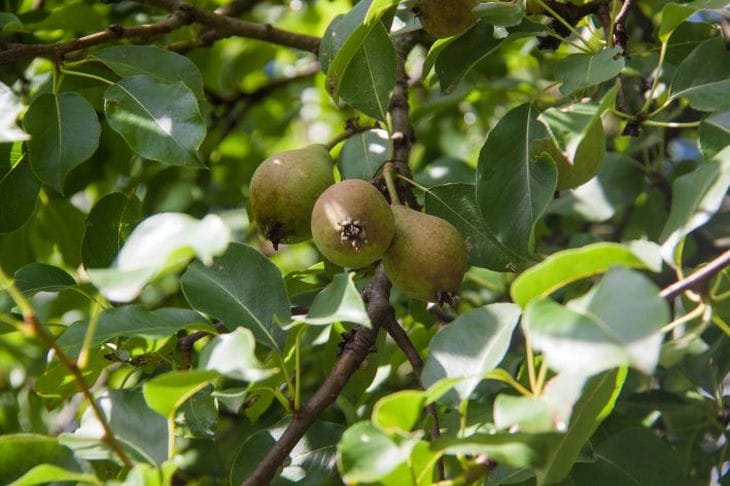- Fungal diseases: a common cause
- Bacterial infections: dangerous pathogens
- Pests: A Threat to Leaves
- Improper care: consequences of mistakes
- Adverse weather conditions: environmental influences
- Diagnosing the problem: determining the cause
- Treatment methods: saving the pear
- Prevention: preventing problems
Why did the leaves on the pear tree turn black: finding the causes and ways to eliminate the problem
The pear is a widely known fruit tree that is highly prized for its aromatic and juicy fruits.
However, gardeners sometimes encounter the problem of blackening leaves on pear trees.
This phenomenon can be caused by various factors, ranging from improper care to serious illnesses, says Anastasia Kovrizhnykh .
It is important to diagnose the cause of blackening of leaves in a timely manner in order to take appropriate measures and save the tree.
Fungal diseases: a common cause
One of the most common causes of blackening of leaves on a pear tree is fungal diseases such as scab, powdery mildew and black cancer. These diseases develop in conditions of high humidity and heat. With scab, dark spots appear on the leaves, which gradually increase in size and merge.

Powdery mildew causes the leaves to become covered with a white coating that gradually darkens. Black canker is a dangerous disease that affects all parts of the tree, including leaves, trunk, and fruits.
Bacterial infections: dangerous pathogens
Bacterial infections can also be the cause of blackening of leaves on pear trees. One such infection is fire blight.
With this disease, the leaves turn black and dry out, starting from the tips. Bacterial burn is a dangerous disease that can lead to the death of the tree.
Pests: A Threat to Leaves
Blackening of leaves on pear trees can be caused by pests such as pear leafhoppers, pear mites, and pear fruit moths.
The pear leafhopper sucks the sap from the leaves, causing them to turn yellow and black. The pear mite also feeds on the sap of the leaves, causing them to deform and turn black. The pear fruit moth damages the fruit and leaves, which can cause them to turn black and fall off.
Improper care: consequences of mistakes
Blackening of leaves on a pear tree can be a consequence of improper care. Insufficient or excessive moisture, lack of nutrients, improper pruning – all this can weaken the tree and increase its susceptibility to diseases and pests.
Adverse weather conditions: environmental influences
Blackening of leaves on a pear tree can be caused by adverse weather conditions such as frost, drought or hail. Frost can damage young leaves and shoots, causing them to turn black and fall off. Drought can cause the tree to become dehydrated and the leaves to turn black. Hail can damage leaves and fruit, which can also cause them to turn black.
Diagnosing the problem: determining the cause
In order to properly treat a pear with blackened leaves, it is necessary to determine the cause of this phenomenon. Carefully examine the tree and pay attention to the following signs:
- Presence of spots on leaves: The shape, color and size of the spots may indicate a specific disease or pest.
- Condition of leaves: yellowing, curling, drying of leaves can be signs of various problems.
- Presence of pests: carefully inspect the leaves and shoots for the presence of insects or their larvae.
- Soil condition: lack or excess of moisture, lack of nutrients can be the cause of weakening of the tree.
Treatment methods: saving the pear
Treatment for a pear with blackened leaves depends on the cause of the phenomenon. Here are some general recommendations:
- Fungal diseases: Treat the tree with fungicides according to the instructions. Remove and destroy affected leaves and fruits.
- Bacterial infections: Treat the tree with antibiotics according to the instructions. Remove and destroy the affected parts of the tree.
- Pests: Treat the tree with insecticides according to the instructions. Use pest traps.
- Incorrect care: adjust watering, fertilizing and pruning of the tree.
- Adverse weather conditions: protect the tree from frost, drought or hail.
Prevention: preventing problems
To prevent blackening of pear leaves, it is necessary to observe the following preventive measures:
- Choose pear varieties that are resistant to diseases and pests.
- Follow the rules for planting and caring for the tree.
- Inspect the tree regularly for pests and signs of disease.
- Carry out preventive treatments with fungicides and insecticides.
- Remove and destroy affected parts of the tree promptly.
Earlier we talked about how to fight late blight .
